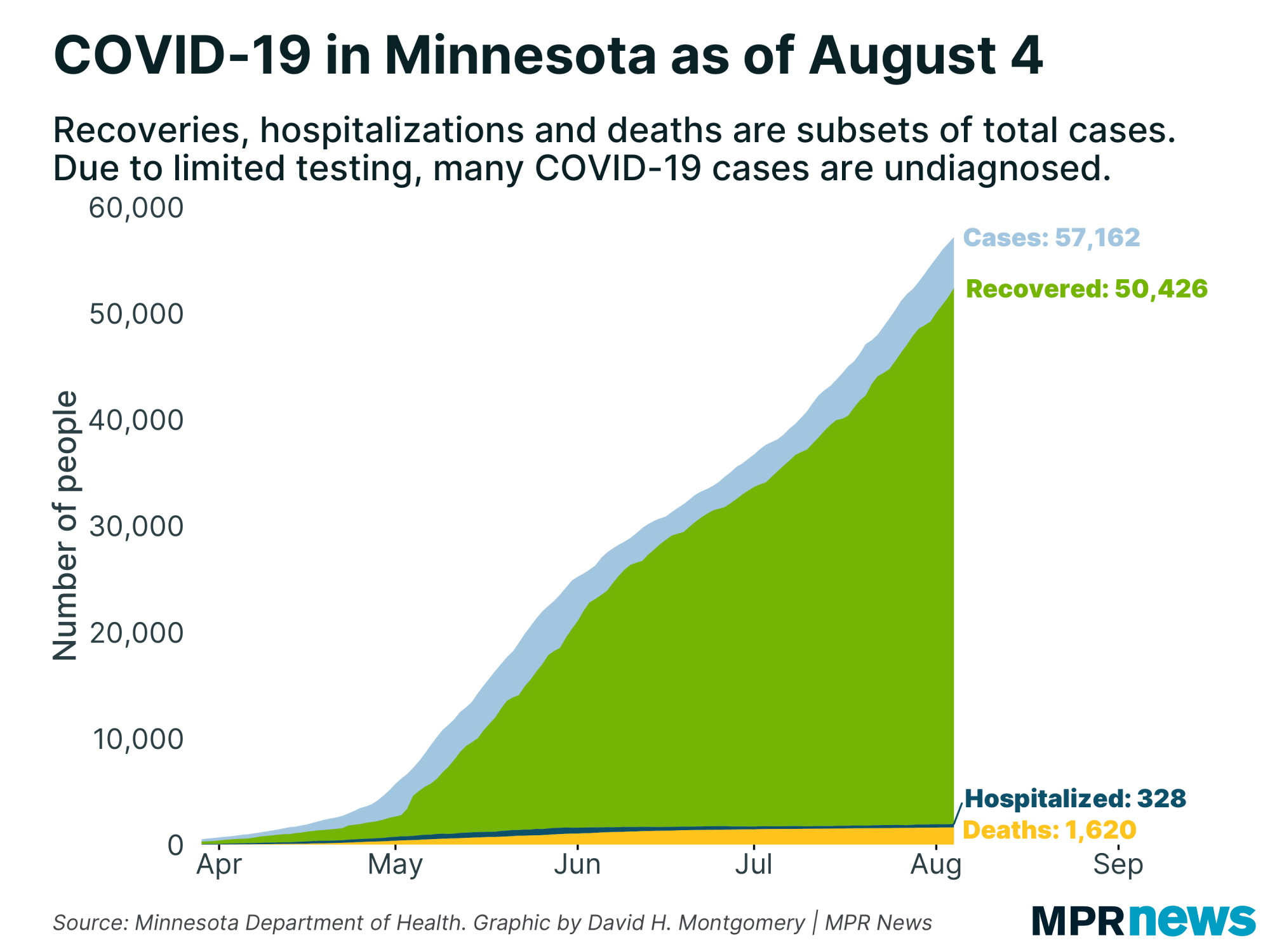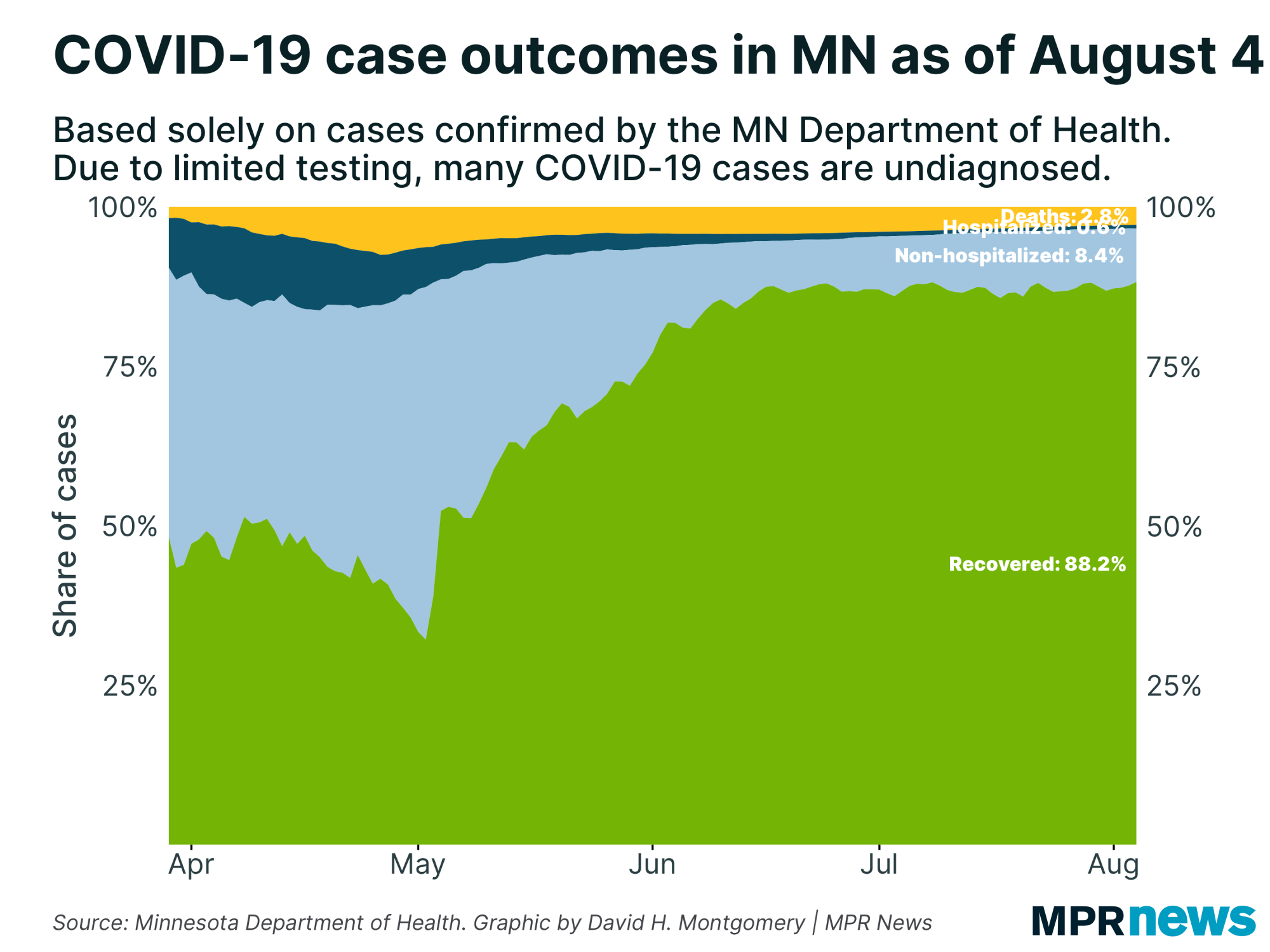July 16 update on COVID-19: New cases up as deaths, hospitalizations flatten

Go Deeper.
Create an account or log in to save stories.
Like this?
Thanks for liking this story! We have added it to a list of your favorite stories.
Updated: 4:55 p.m.
COVID-19’s “Yes, but…” trend in Minnesota continued Thursday with another report of hopeful and concerning data: The daily count of new deaths, current hospitalizations and intensive care cases continue to flatten even as the number of new cases leaps.
Health Department data showed eight more deaths from the disease, putting Minnesota’s toll at 1,526 since the pandemic began, continuing a nearly monthlong trend of mostly single-digit daily deaths.
Total current hospitalizations (249) and the count of people currently needing intensive care (103) dipped from Wednesday. ICU cases — a crucial metric as officials try to manage the disease’s spread so it doesn’t overwhelm the care system — are at a level not seen since mid-April.
Still, Minnesota on Thursday reported another 611 confirmed positive tests for the disease, part of an overall trend of steeply rising cases seen in the past few weeks.
Turn Up Your Support
MPR News helps you turn down the noise and build shared understanding. Turn up your support for this public resource and keep trusted journalism accessible to all.
Officials have been bracing Minnesota to expect hospitalizations and death counts to grow as the number of new cases jumps. Right now, though, even as new cases soar, the percentage of active cases in the hospital has never been lower.
Of the 44,347 confirmed cases of COVID-19 in Minnesota since the pandemic began, about 86 percent of those people have recovered to the point they no longer need to be isolated.
Among those who’ve died, nearly 80 percent had been living in long-term care or assisted living facilities, nearly all had some chronic health problem.
‘Worrisome point’
The latest numbers come a day after state health leaders pressed Minnesotans to stay vigilant to slow the spread of COVID-19 and encouraged families to make plans for others to care for young children should parents and other caregivers fall ill with the disease.

"We are, in fact, at a worrisome point that our numbers are going up,” Dr. Ruth Lynfield, the state epidemiologist, said Wednesday of the recent spike in daily case counts. "This really is a moment for all of us to take a step back and think about what we can do to slow transmission."
So far, state leaders have emphasized personal responsibility when it comes to mask-wearing, social distancing and hygiene. DFL Gov. Tim Walz is weighing a statewide mask mandate, but has yet to enact one — despite pleas from medical groups and the state Health Department.
Walz expressed concern earlier this week that Minnesotans were lagging on their mask-wearing. But Republicans, including Senate Majority Leader Paul Gazelka, R-East Gull Lake, have said a statewide mandate would be a mistake.

As mask use appears to lag, cases continue to tick up and the state is encouraging parents to make a plan in case they or their kids’ caregivers fall ill with COVID-19.
Kris Ehresmann, the state’s infectious disease director, said parents should pull together information on children’s medical and educational needs, routines and comforts. The Health Department has posted “make a plan” guidance on its website.
Lynfield said it will be “a long time in the best scenario” before an effective COVID-19 vaccine becomes available. Until then, she said, people shouldn’t let down their guard, no matter how tired they are of wearing a mask.
“It is really up to us to make the choice to limit the spread,” Lynfield said. “The virus is out there. We want to be able to live in a pandemic as best we can.”
20-somethings drive new cases
State health officials continue to worry about the recent spike of coronavirus cases in younger Minnesotans, with current fears including that those infected will inadvertently spread the virus to more vulnerable populations.

Minnesotans in their 20s now make up the age group with the most confirmed cases, with more than 10,000 since the outbreak started. The median age of Minnesotans infected has been trending down in recent weeks and is now below 38 years old.
Young people still account for the majority of new confirmed cases in Minnesota, although 20-somethings have fallen from around 40 percent of new cases a few weeks ago to around 30 percent as of Thursday.
While current hospitalization counts in Minnesota remain relatively low, “we are likely going to see increases in hospitalizations because of the ripple effect” of younger people becoming infected, Ehresmann said earlier in the week, adding that young adults “don’t live in a vacuum.”
Amid recent case upticks, worries over another PPE shortage
State health officials on Wednesday also noted that there are some personal protective equipment supply issues popping up again globally. Health Commissioner Jan Malcolm said that hospitals have their own supplies in addition to a shared stockpile, and that the state currently has about 106 days worth of N95 respirator masks and 60 days of nonlatex gloves.
She said there has been some testing supplies shortages in recent days, and she expects similar shortages with personal protective equipment.
"We're not assuming we have enough,” she said, “we do have a very good supply right now, but because of what we're seeing with global supply chain issues reemerging, we're continuing to look to source additional supplies of some of the high quality masks and gowns and the like that we anticipate needing as this pandemic evolves.”
Malcolm said she expects the demand to grow in the fall as the flu season begins.
Walz working on schools plan
The governor on Wednesday said he is working on a plan to get K-12 students back in classrooms safely. In an interview with WCCO, Walz said he planned to spend some of his day working on a plan for the upcoming academic year.
Walz and other state leaders have told schools to prepare for three different scenarios for resuming school in the fall: distance learning, in-person learning or a hybrid of the two approaches. Officials have said that they will announce by the end of July which scenario districts and charters should choose.
Meatpacking hot spots remain
Many of the outbreaks outside the Twin Cities metro area are focused around meatpacking plants. Officials have intensified testing in those hot spots, uncovering more infections.
That includes Mower County in southeastern Minnesota, where there were 996 confirmed cases as of Thursday. Mower County is home to Hormel Foods and Quality Pork Processors. Both have been partnering with Mayo Clinic to ramp up employee testing.
While some of Mower County’s positive cases are associated with people who work in the facilities and with the people they live with, county officials say they are also seeing transmission among people who live in the county but work in other counties where coronavirus is present.
Nobles, in southwestern Minnesota, reported 1,698 confirmed cases as of Thursday, the same as Wednesday, with six deaths. About 1 in 13 people now have tested positive for COVID-19 in the county since the pandemic began, although the count of new cases has slowed considerably in recent weeks.

Worthington’s massive JBS pork processing plant was the epicenter of the Nobles outbreak. The JBS plant shut on April 20 but has since reopened with expanded hygiene and health monitoring measures.
Similar problems have been reported in Stearns County, where COVID-19 cases tied to two packing plants — Pilgrim’s Pride poultry plant in Cold Spring and Jennie-O Turkey in Melrose — skyrocketed in May. An undisclosed number of workers at both plants have tested positive for the virus.
There were about 55 confirmed cases in Stearns County in early May. By Thursday, confirmed cases were at 2,596 with 19 deaths.
Kandiyohi County in west-central Minnesota is also dealing with a significant caseload more than two months after officials with the Jennie-O turkey processing plant there said some employees had tested positive for the coronavirus.
As of Thursday, the Health Department reported 601 people have now tested positive. The county had confirmed three COVID-19 cases in late April.
Cases have also climbed noticeably in Lyon County (369 cases), around a turkey processor in Marshall. Cases the past few weeks have also grown in Cottonwood County (146 cases), home to a pork processing plant in Windom in southern Minnesota, but the counts there have since stabilized.

Developments from around the state
Walker Art Center, Mia reopen after COVID-19 closures
Two of the state’s best-known museums are reopening Thursday, after months of being closed due to the coronavirus.
The Walker Art Center is reopening for limited hours Thursday through Sunday. The museum is requiring tickets for all visitors, with designated times to help facilitate social distancing. The first hour of tickets on Thursdays and Fridays will be for people with elevated risk of serious illness due to COVID-19.
The Minneapolis Institute of Arts is also reopening Thursday, with similar restrictions, and special hours on Thursdays for people at higher risk for COVID-19.
Tickets for both museums are available online or by phone.
— Tim Nelson | MPR News
Spurred by pandemic, Black Bear Casino in Carlton goes smoke-free
The Fond Du Lac Band of Lake Superior Chippewa has banned smoking at its main casino in Carlton, a major step from standard practice at tribal gaming operations in Minnesota.
The ban went into effect Wednesday morning in all buildings at the Black Bear Resort Casino which sits next to Interstaste 35 south of Cloquet, Minn. The outright ban is unprecedented among high-profile tribal gaming operations in Minnesota. The Fond Du Lac band prohibited smoking at its much smaller casino in downtown Duluth a month ago.
Black Bear general manager Daniel George LaPrairie said the decision was in part because people smoking were not wearing masks, prompting concern about the potential spread of COVID-19.
“Employees and guests and the community are the forefront of our thoughts here. We are definitely concerned with the health and well being of our community,” he said. “This is a step in the right direction, and we’ll keep making those steps in those decisions to keep us safe here.
LaPrairie said the decision was temporary, but that it may last beyond the COVID-19 outbreak. He said cultural attitudes both in Native and wider communities were moving against smoking, and that he believes tribal gaming may take wider action against the practice.
— Tim Nelson | MPR News
Top headlines
Target, CVS Health join list of major retailers mandating masks: Target, CVS Health and Publix Super Markets on Thursday joined the growing list of major retailers that will require customers to wear masks as cases of COVID-19 spike. Target's policy will go into effect Aug. 1., while CVS's rule will start Monday.
COVID-19 in Minnesota
Data in these graphs are based off Minnesota Department of Health cumulative totals released at 11 a.m. daily. You can find more detailed statistics on COVID-19 at the Health Department website.
The coronavirus is transmitted through respiratory droplets, coughs and sneezes, similar to the way the flu can spread.


